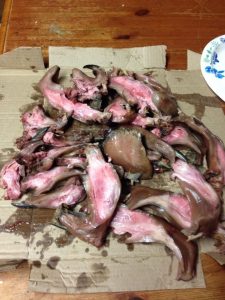Last week a friend told me about about her introduction to pruno – the legit kind, not the the stuff used to impress your Orange is the New Black fan friends. My friend’s sister, who is in prison for meth fabrication just had time added to her sentence for fermenting jailhouse hooch.
To make pruno, a sugar source (like fruit acquired from a prison lunch) is put into in a bottle or bag, the naturally occurring yeast should convert the carbs into alcohol – creating some low-cost wine. If the sugar source is acidic fruit, the low pH will suppress the germination of C. bot spores. If a potato is added by the amateur microbiologist it can raise the pH enough to allow toxin formation.
The same sorta thing happens with seal flipper the traditional method of making the northern delicacy usually includes burying the appendages. It used to be directly in the ground but plastic containers are generally used now – which can turn the fermentation into an aerobic type. If the pH drop is incomplete, coupled with no oxygen, there’s a botulism risk.
According to CBC News some folks in Nunavut (that’s in Northern Canada) might have been exposed to the deadly toxin through fermented (or semi fermented) seal
 Nunavut’s health department is warning people in Sanikiluaq not to eat fermented seal, after it received reports of people becoming sick with botulism after consuming the meat.
Nunavut’s health department is warning people in Sanikiluaq not to eat fermented seal, after it received reports of people becoming sick with botulism after consuming the meat.
In a news release, the department says it’s investigating the reports.
Anyone with symptoms should contact the health centre in Sanikiluaq.
The Department is also asking anyone with leftover fermented seal that could be used for testing to call their regional environmental health officer.
